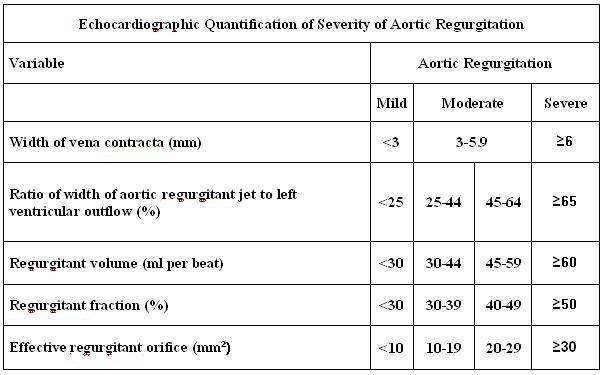Aortic regurgitation echocardiography: Difference between revisions
No edit summary |
No edit summary |
||
| Line 29: | Line 29: | ||
===Severe aortic insufficiency 1=== | ===Severe aortic insufficiency 1=== | ||
{{#ev:googlevideo|4226733785410043550}} | |||
===Severe aortic insufficiency 2=== | ===Severe aortic insufficiency 2=== | ||
{{#ev:googlevideo|4894210068874837906}} | |||
===Severe aortic insufficiency 3=== | ===Severe aortic insufficiency 3=== | ||
| Line 38: | Line 38: | ||
Severe acute aortic insufficiency is considered a [[medical emergency]]. There is a high [[death|mortality]] rate if the individual does not undergo immediate surgery for [[aortic valve replacement]]. If the acute AI is due to aortic valve [[endocarditis]], there is a risk that the new valve may become seeded with [[bacteria]]. However, this risk is small. <ref>{{cite journal |author=al Jubair K, al Fagih MR, Ashmeg A, Belhaj M, Sawyer W |title=Cardiac operations during active endocarditis |journal=J. Thorac. Cardiovasc. Surg. |volume=104 |issue=2 |pages=487–90 |year=1992 |pmid=1495315 |doi=}}</ref> | Severe acute aortic insufficiency is considered a [[medical emergency]]. There is a high [[death|mortality]] rate if the individual does not undergo immediate surgery for [[aortic valve replacement]]. If the acute AI is due to aortic valve [[endocarditis]], there is a risk that the new valve may become seeded with [[bacteria]]. However, this risk is small. <ref>{{cite journal |author=al Jubair K, al Fagih MR, Ashmeg A, Belhaj M, Sawyer W |title=Cardiac operations during active endocarditis |journal=J. Thorac. Cardiovasc. Surg. |volume=104 |issue=2 |pages=487–90 |year=1992 |pmid=1495315 |doi=}}</ref> | ||
{{#ev:googlevideo|3075471538892457393}} | |||
==References== | ==References== | ||
Revision as of 19:01, 29 January 2012
|
Aortic Regurgitation Microchapters |
|
Diagnosis |
|---|
|
Treatment |
|
Acute Aortic regurgitation |
|
Chronic Aortic regurgitation |
|
Special Scenarios |
|
Case Studies |
|
Aortic regurgitation echocardiography On the Web |
|
American Roentgen Ray Society Images of Aortic regurgitation echocardiography |
|
Risk calculators and risk factors for Aortic regurgitation echocardiography |
Editor-In-Chief: C. Michael Gibson, M.S., M.D. [1]; Associate Editor-In-Chief: Cafer Zorkun, M.D., Ph.D. [2], Varun Kumar, M.B.B.S., Lakshmi Gopalakrishnan, M.B.B.S.
Overview
The most common test used for the evaluation of the severity of aortic insufficiency is the echocardiogram, which can provide two-dimensional views of the regurgitant jet, and allow measurement of the velocity and volume of the jet.
Echocardiographic Findings in Severe Aortic Insufficiency
The echocardiographic findings in severe aortic regurgitation include:
- An AI color jet dimension > 60 percent of the left ventricular outflow tract (LVOT) diameter (may not be true if the jet is eccentric)
- The pressure half-time of the regurgitant jet is < 250 msec
- Early termination of the mitral inflow (due to increase in LV pressure due to the AI.)
- Early diastolic flow reversal in the descending aorta.
- Regurgitant volume > 60 ml
- Regurgitant fraction > 55 percent
 |
- Increased duration between E and A peaks
- Fluttering of the anterior mitral valve leaflet due to AI jet turbulence
- Clinical setting to decide mechanism
Severe aortic insufficiency 1
{{#ev:googlevideo|4226733785410043550}}
Severe aortic insufficiency 2
{{#ev:googlevideo|4894210068874837906}}
Severe aortic insufficiency 3
Severe acute aortic insufficiency is considered a medical emergency. There is a high mortality rate if the individual does not undergo immediate surgery for aortic valve replacement. If the acute AI is due to aortic valve endocarditis, there is a risk that the new valve may become seeded with bacteria. However, this risk is small. [2]
{{#ev:googlevideo|3075471538892457393}}
References
- ↑ Zoghbi WA, Enriquez-Sarano M, Foster E, Grayburn PA, Kraft CD, Levine RA, Nihoyannopoulos P, Otto CM, Quinones MA, Rakowski H, Stewart WJ, Waggoner A, Weissman NJ (2003). "Recommendations for evaluation of the severity of native valvular regurgitation with two-dimensional and Doppler echocardiography". Journal of the American Society of Echocardiography : Official Publication of the American Society of Echocardiography. 16 (7): 777–802. doi:10.1016/S0894-7317(03)00335-3. PMID 12835667. Retrieved 2011-03-02. Unknown parameter
|month=ignored (help) - ↑ al Jubair K, al Fagih MR, Ashmeg A, Belhaj M, Sawyer W (1992). "Cardiac operations during active endocarditis". J. Thorac. Cardiovasc. Surg. 104 (2): 487–90. PMID 1495315.
